|
|
|
|
Ibike
Korea People-to-People Program
|
|
|
|
|
| |
|
 Photo essay: Jejusi to
Seongsan Photo essay: Jejusi to
Seongsan
|
| |
|
(39mi, 63km)
Points of Interest: Manjanggul lava tunnel, Maze Park, shore road, wind farm |
| |
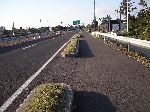 |
A major feature of Jeju
Island is almost continuous bicycle lanes on highway 12, which circumnavigates
the island. Generally there are bike lanes on both sides of the roads.
The facilities tend to be the best where they are least likely to be used.
[For more discussions of non-motorized facilities on Jeju see
www.ibike.org/engineering/kr-nmt/index.htm#Jeju |
| |
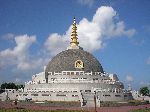 |
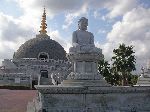 This Buddhist temple was
distinctly different than any I saw on the mainland -- much more Indian in
character.. This Buddhist temple was
distinctly different than any I saw on the mainland -- much more Indian in
character.. |
| |
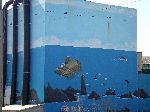 |
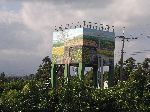
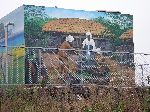
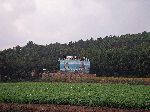
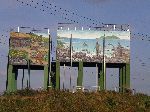 A signature feature of Jeju is its painted water tanks. The subject of the
murals tends to reflect a special character or activity of the specific section
of the island.
A signature feature of Jeju is its painted water tanks. The subject of the
murals tends to reflect a special character or activity of the specific section
of the island. |
| |
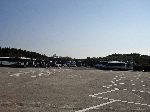
|
Even at 9 a.m. the parking lot at the volcano
crater is already starting to fill up with tour buses. Most of the buses
are filled with school children, though there are groups of adults as well, and
some visitors come as a family in private cars. At least all the vehicles
have high occupancy rates, but Jeju's popular destinations still generate so
much traffic that they are unpleasant to get to by bicycle. |
| |
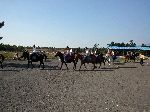
|
School girls on an outing to Jeju Island stop for
horseback riding. The ride consisted of three loops around a track which
took less than two minutes. School groups from all over South Korea come
to Jeju to visit the natural history and cultural sites -- as well as have some
fun. |
| |
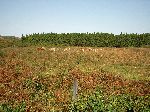
|
The only free range cattle I saw in all of South
Korea were on Jeju. I saw a few isolated cows staked on the mainland, but
the vast majority of South Korean cows seem to spend their entire lives in
barns. |
| |
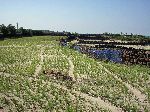
|
Jeju is said to have wind, rocks and women.
Here the rocks are used to block the wind so that crops can be grown in the
sandy soil. Presumably women do the farming -- although Jeju culture is
distinguished for its equalitarianism and equality between the sexes. |
| |
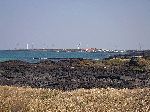
|
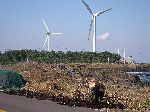 More evidence of good winds are the wind farms
(wind powered turbines) at the east and west end of the island. This
project had about a dozen towers which were rate at 600 kW and 750 kW. It
is an interesting juxtaposition with the turbine and a woman laying out seaweed
to dry (right). More evidence of good winds are the wind farms
(wind powered turbines) at the east and west end of the island. This
project had about a dozen towers which were rate at 600 kW and 750 kW. It
is an interesting juxtaposition with the turbine and a woman laying out seaweed
to dry (right). |
| |
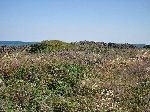
|
Hwanhae Great Wall is a stone wall covering around
120 km of the shore of Jeju Island. The Goryeo Court ordered Yeongam
Vice-envoy Kim Soo and Gen. Goh Teorim to build the walls in order to prevent
the Sambyeolcho Army from entering Tamna. The Sambyeolcho Army went
to Jindo Island, where the Yongjang Fortress was built in protest against
Goryeo's humiliating reconciliation with Yuan, but the fortress was besieged by
the Goryeo and Mongol armies. The wall defended against attacks by
Japanese pirates at the end of the Goryeo Dynasty and Joseon Dynasty, and
foreign warships, such as England's, in the 18th and 19th centuries. |
| |
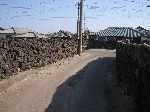
 |
One of the nicest part of
Jeju Island is the "shore road". Currently, the "shore
road" still goes through the narrow streets of many seaside villages. This
"road diet" keeping the buses off much of the route and slowing cars down so
that they choose to take highway 12 instead. There is currently a project
to connect many of the isolated sections of shore road by building big roads
through and on the coastal side many of these villages, bisecting them or
cutting them off from the shore. Unfortunately they are destroy some of
the islands reserves of tranquility and opportunities to promote strong high
quality ecotourism. Both of which are lost opportunities that will
probably be deeply regretted in twenty years. |
| |
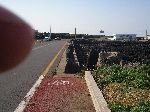
|
Here the bike lane on the
shore road abruptly ends. Presumably you are suppose to wait for a
helicopter to take you to the next section or turn back. If you turn back,
you will find that there is a bike lane on only one side of the road. In
the off season traffic volumes are pretty low so it is not a problem to ride in
the road. Many people seem to feel like they should ride the wrong way in
the narrow bike lane, which when they meet an on-coming cyclists and on coming
traffic together, creates a potential very dangerous situation. |
| |
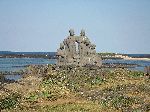
|
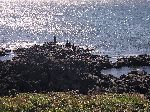 Jeju is famous for its
women divers. They are honored with art pieces at numerous places around the
island. They work cooperatively in small groups. Depending upon the
weather and the tides, they can still be seen at work at several
locations on the island. Jeju is famous for its
women divers. They are honored with art pieces at numerous places around the
island. They work cooperatively in small groups. Depending upon the
weather and the tides, they can still be seen at work at several
locations on the island. |
| |
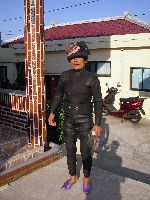
|
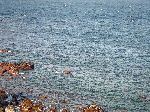 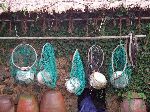 Now-a-days the women divers
wear wet suits while they work. The mostly collect shell fish (i.e. abalone,
urchins, oysters). You can spot them in the water by their
traditional white floats (right). Other changes in the diver community are their
numbers are dwindling, and, as a group, they are aging -- there are easier and
more lucrative occupations available for young people to aspire to these days. Now-a-days the women divers
wear wet suits while they work. The mostly collect shell fish (i.e. abalone,
urchins, oysters). You can spot them in the water by their
traditional white floats (right). Other changes in the diver community are their
numbers are dwindling, and, as a group, they are aging -- there are easier and
more lucrative occupations available for young people to aspire to these days. |
| |
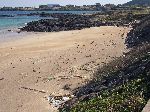
|
Unfortunately, one of the details that seems to be
being neglected in the landscape of South Korea is liter in the ocean and
subsequently on the beaches. Upland area are much better policed for liter
than the coast. |
| |
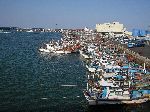
|
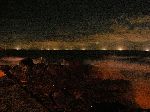 A
fleet of squid boat Seongsan (left). Like on the East Sea (east coast) these boat
go out at night and light-up the horizon (right). But different from the east
coast, the boats are generally smaller and there is rarely squid drying on
lines in the villages. They must processes the squid in a totally
different way. A
fleet of squid boat Seongsan (left). Like on the East Sea (east coast) these boat
go out at night and light-up the horizon (right). But different from the east
coast, the boats are generally smaller and there is rarely squid drying on
lines in the villages. They must processes the squid in a totally
different way. |
| |
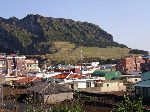
|
 Sunrise Peak from Seongsan
(left) and Seongsan from Sunrise Peak (right). Sunrise Peak from Seongsan
(left) and Seongsan from Sunrise Peak (right). |
| |
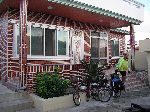
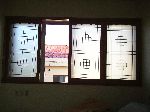 |
Here is our "minbak" in Seongsan. Hotel rooms in South
Korea are "western" or
"traditional" (ondol). Traditional rooms have no bed and a heated floor (ondol).
The bedding is folded in the corner and the guest lays out the pad, comforter
and pillows. Minbaks are usual
"ondol", the bathroom is exterior and shared with other guest and they
usually don't have any appliances. In hotels, motels and yeogwans (small
hotels) a typical room has a full
bathrooms, hairdryer, television, mini-refrigerator and telephone. To the
extent that television is an insight into a culture, Korean television has a
plethora of shopping channels, historical and contemporary domestic relationship dramas,
the requisite sports channels (baseball, golf, fishing, etc.) and actions movies and
network television. But more interest were dedicated channels to lectures
on math (i.e. calculus and algebra), hard science, and "Go" (a board game where
players use black and white stones to capture territory, that is very popular in
China, Japan and Korea). |
|
Jejusi

 Daejeong Daejeong |
|
    |
 |
|
|
 Please
contact us if you would like to be added to
Ibike's mailing list or have questions, comments, corrections or criticism. (Also, please let us know how you learned about us and
found this site.) Privacy policy. Please
contact us if you would like to be added to
Ibike's mailing list or have questions, comments, corrections or criticism. (Also, please let us know how you learned about us and
found this site.) Privacy policy.
 IBF Homepage
IBF Homepage  Ibike Programs
Ibike Programs
 Ibike Schedule
Ibike Schedule
 Search
Search
"Hosted by
DreamHost - earth friendly web hosting"
Created by David Mozer
Copyright ?1993-2018 Ibike LLC. All rights reserved.
|
 Photo essay: Jejusi to
Seongsan
Photo essay: Jejusi to
Seongsan
 This Buddhist temple was
distinctly different than any I saw on the mainland -- much more Indian in
character..
This Buddhist temple was
distinctly different than any I saw on the mainland -- much more Indian in
character..



 A signature feature of Jeju is its painted water tanks. The subject of the
murals tends to reflect a special character or activity of the specific section
of the island.
A signature feature of Jeju is its painted water tanks. The subject of the
murals tends to reflect a special character or activity of the specific section
of the island.




 More evidence of good winds are the wind farms
(wind powered turbines) at the east and west end of the island. This
project had about a dozen towers which were rate at 600 kW and 750 kW. It
is an interesting juxtaposition with the turbine and a woman laying out seaweed
to dry (right).
More evidence of good winds are the wind farms
(wind powered turbines) at the east and west end of the island. This
project had about a dozen towers which were rate at 600 kW and 750 kW. It
is an interesting juxtaposition with the turbine and a woman laying out seaweed
to dry (right).




 Jeju is famous for its
women divers. They are honored with art pieces at numerous places around the
island. They work cooperatively in small groups. Depending upon the
weather and the tides, they can still be seen at work at several
locations on the island.
Jeju is famous for its
women divers. They are honored with art pieces at numerous places around the
island. They work cooperatively in small groups. Depending upon the
weather and the tides, they can still be seen at work at several
locations on the island. 

 Now-a-days the women divers
wear wet suits while they work. The mostly collect shell fish (i.e. abalone,
urchins, oysters). You can spot them in the water by their
traditional white floats (right). Other changes in the diver community are their
numbers are dwindling, and, as a group, they are aging -- there are easier and
more lucrative occupations available for young people to aspire to these days.
Now-a-days the women divers
wear wet suits while they work. The mostly collect shell fish (i.e. abalone,
urchins, oysters). You can spot them in the water by their
traditional white floats (right). Other changes in the diver community are their
numbers are dwindling, and, as a group, they are aging -- there are easier and
more lucrative occupations available for young people to aspire to these days. 

 A
fleet of squid boat Seongsan (left). Like on the East Sea (east coast) these boat
go out at night and light-up the horizon (right). But different from the east
coast, the boats are generally smaller and there is rarely squid drying on
lines in the villages. They must processes the squid in a totally
different way.
A
fleet of squid boat Seongsan (left). Like on the East Sea (east coast) these boat
go out at night and light-up the horizon (right). But different from the east
coast, the boats are generally smaller and there is rarely squid drying on
lines in the villages. They must processes the squid in a totally
different way.
 Sunrise Peak from Seongsan
(left) and Seongsan from Sunrise Peak (right).
Sunrise Peak from Seongsan
(left) and Seongsan from Sunrise Peak (right).
 Please
contact us if you would like to be added to
Ibike's mailing list or have questions, comments, corrections or criticism. (Also, please let us know how you learned about us and
found this site.) Privacy policy.
Please
contact us if you would like to be added to
Ibike's mailing list or have questions, comments, corrections or criticism. (Also, please let us know how you learned about us and
found this site.) Privacy policy.![]() IBF Homepage
IBF Homepage ![]() Ibike Programs
Ibike Programs
![]() Ibike Schedule
Ibike Schedule
![]() Search
Search



